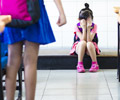Whether it's pushing, punching, spreading rumors or name-calling, bullying has no place at school or in cyberspace.
Whether it’s pushing, punching, spreading rumors or name-calling, bullying has no place at school or in cyberspace. However, it is something which is widely prevalent.
Therefore, Tammy Wilgenbusch, Ph.D., a clinical psychologist with University of Iowa Children’s Hospital, has provided some tips on how to handle bullying and explained why it occurs."Bullying can start at any age but it increases and then peaks in early adolescence, between sixth and ninth grades. At that time, children are developing their personalities and independence so they may be more likely to take their insecurities out on or try to wield power over others. By later adolescence, they have a better sense of self and are less likely to take insecurities out on others," Wilgenbusch said.
Bullying is a negative or aggressive act that is systematic and ongoing. It can be instigated by one person or a group of individuals.
"Typically, the person doing the bullying is seen as more powerful, whether it is physical or social status or better language skills," Wilgenbusch said.
Children who are bullied are at higher risk of mental health problems, particularly depression and anxiety. Some studies show that children who display more anger are more likely to bully because they do not have proper anger-management skills, Wilgenbusch explained.
Children who are bullied can develop personality or temperament changes, such as withdrawal, sleep or appetite changes, and decreased academic performance.
Advertisement
Teasing is a form of bullying, and research shows that children rate it as the most common form of bullying they encounter.
Advertisement
When it comes to physical bullying, however, it is best to report attacks.
"If the aggression is physical, the bullier needs to face consequences," Wilgenbusch said.
Parents can meet with teachers and school personnel.
Wilgenbusch emphasized that bullying prevention may require school-wide changes in the environment.
"The change needs to take place at all levels - from the principal to the students - to create an environment where bullying is not appropriate and instead focus on positive interactions," she said.
Wilgenbusch noted that "relational bullying" - which is bullying to hurt someone’s status within a social group - is much more common because of the Web and access to blogs and social networking groups.
"It is key for parents to monitor and observe what their children are posting and looking at online. Supervision is more difficult when it comes to Web activities but you need to talk to your children and help them problem solve," she sad.
Source-ANI
LIN









